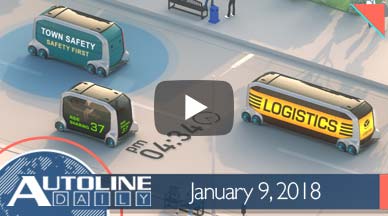
Runtime: 8:01
0:30 Car Sharing to Hurt Car Sales?
1:17 Big Trucks Post Big 2017
1:54 Musk to Open Old-School Drive-In
2:45 Byton Reveals Electric SUV
3:56 Toyota Develops Mobility Solutions for Businesses
5:40 Kia Presents Vision for Future Mobility
6:49 Hyundai’s Next-Gen Fuel-Cell Vehicle
Visit our sponsors to thank them for their support of Autoline Daily: Bridgestone , Dow Automotive Systems and Lear Corporation.
On today’s show… a new study says ride hailing services are hurting car sales… Hyundai reveals its next-gen fuel-cell vehicle… and Toyota introduces an autonomous pod vehicle aimed at businesses. All that and more coming right up on Autoline Daily.
This is Autoline Daily the show for enthusiasts of the automotive industry.
CAR-NOT-SO-SHARING
Are ride hailing and car sharing going to hurt car sales? That’s what a study from AlixPartners suggests. The consulting company interviewed 5,000 people in seven major countries, aged 16 and up. It found that 9% of millennials in the U.S. have avoided getting a driver’s license thanks to ride hailing services like Uber. If the same percentage of Americans had a driver’s license today as they did in the year 2000 there would be 10 to 12 million more cars on the road. In Europe half the respondents say they have postponed or avoided buying a new car thanks to ride hailing and car sharing. Alix Partners says that ride hailing is increasing in popularity.
BIG TRUCKS SEE BIG SALES
We’ve tracked the success of big truck sales in the American market and that trend continued in December. Orders for Class 8 semis topped the 37,000 unit mark, which was an increase of 77% compared to December of 2016. In fact, sales of those big rigs for all of 2017 saw the same increase, 77% and production is forecast to keep increasing in 2018. That’s good news because big truck sales can be an indicator of where the economy is headed.
DINERS, DRIVE-INS & FAST CHARGING
His vehicles are futuristic with cutting-edge technology, but Elon Musk just announced, on Twitter of course, that he’s going to open an old-school drive-in, equipped with a diner and roller skating wait staff no less. The establishment will be at one of Tesla’s new Supercharger stations in LA. Now there’s a nice way to forget about “production hell.” Well, for a few hours at least.
Still to come… a look at new vehicles and technology revealed at CES.
BYTON REVEALS ELECTRIC SUV
Last week we told you about Byton, a new autonomous EV startup from China and now here’s its first vehicle, an SUV concept. We got a pretty good look at the front end in the teaser shots, but it also features a swept back roofline that flows toward those recently highlighted “shark fin” styling elements and into the rear, which has an LED lighting signature just as radical as the front. Byton will offer both a rear-drive and all-wheel drive version of the SUV. The single motor, rear-drive model produces nearly 270-horsepower and about 250-miles of range with a 71-kWh battery pack. The all-wheel drive model has almost 470-horsepower, a 95-kWh battery and 323-miles of range. In addition to the giant front screen, rear seat passengers get their own touchscreen as well. When it goes on sale, in China next year and 2020 in the U.S. and Europe, the SUV will have a starting price of $45,000, but no word if that price includes incentives.
TOYOTA’S SOPHISTICATED e-PALETTE
When it comes to autonomy most of the focus is on moving people from point A to point B. But the technology can also be used to help businesses expand. That’s why Toyota just launched the e-Palette Alliance, to develop mobility solutions for business applications. Amazon, Mazda, Pizza Hut, Uber and DiDi, have all joined the Alliance to begin with. And in the short-term, the companies will help develop a new concept Toyota just revealed at CES called the e-Palette Concept Vehicle. The pod-like electric vehicle is fully autonomous and comes in three different lengths that range from 13- to 23-feet. The e-Palette concept is designed to be scalable and customizable, so for example it could be used for ride-sharing, delivering packages or other applications. And it’s also been designed to allow partner companies to install their own automated systems. Toyota plans to test the e-Palette in the U.S. and other regions beginning in the early 2020s.
Coming up next, Hyundai reveals its all-new fuel-cell vehicle and Kia takes the wraps off an all-electric version of the Niro.
KIA PRESENTS VISION FOR FUTURE MOBILITY
Kia presented its vision for future mobility at CES. It will start equipping its vehicles with connected car technology in 2025, with the goal of having every model in its line-up connected by 2030. The company also revealed it will introduce 16 electrified vehicles by 2025, including a fuel-cell that will debut in 2020. As part of the strategy, the company showed off an all-electric concept of the Niro crossover. It’s powered by a 64-kWh battery pack and a 150-kW electric motor which provides close to 240 miles of range. The Niro EV concept features a new HMI, which controls the infotainment and HVAC systems with touch and gestures controls. Kia is also showing off a second cockpit that features 5G connectivity and its sound separation technology, which allows front and rear passengers to listen to their own music at the same time. And that sounds like technology that would be perfect for ride-sharing.
HYUNDAI’S NEXO-GEN FUEL CELL VEHICLE
And in related news, Kia’s parent company Hyundai revealed its next-gen fuel-cell vehicle. Called NEXO, it’s the first fuel-cell in its line-up built on its own platform, the previous version was a modified Tucson. The NEXO has an estimated range of 370 miles, which is 105 more than the outgoing model. NEXO will be available in select markets around the world starting early this year, and that is part of Hyundai’s strategy to have 18 green vehicles on the market globally by 2025.
And for more from CES, be sure to check out our coverage of the show. John is talking to suppliers and automakers about their developments in technology. Look for those interviews on our website, Autoline.tv starting later today.
But that’s it for this show, thanks for watching and please join us again tomorrow.
Thanks to our partner for embedding Autoline Daily on its website: WardsAuto.com

John McElroy is an influential thought leader in the automotive industry. He is a journalist, lecturer, commentator and entrepreneur. He created “Autoline Daily,” the first industry webcast of industry news and analysis.




